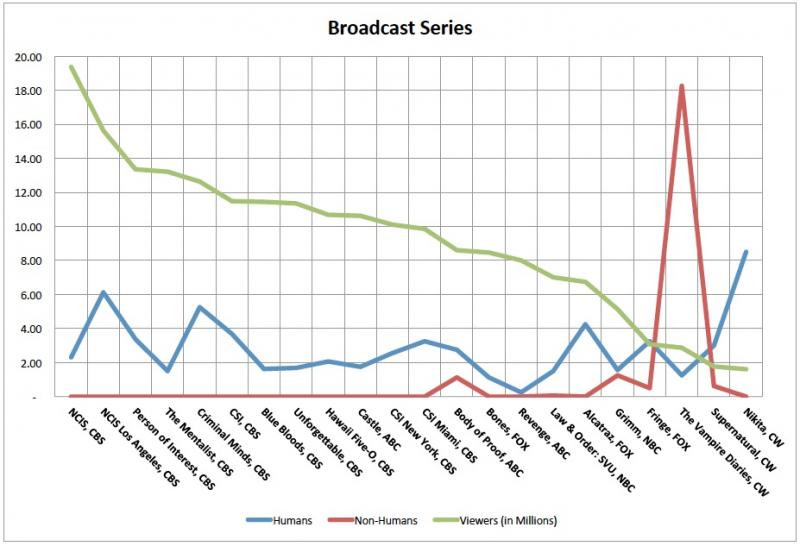2011 Fall TV Body Count Study: Challenges & Results
Return to: TV Body Count Study Summary, Background & Methodology >>
Challenges
As the survey progressed, Funeralwise quickly realized that it was facing some challenges. What appeared to be a relatively straightforward task, counting the number of dead bodies shown in a given television program, was not so clear after all.
- There was a great deal of variation in how watchers interpreted what was a dead body. For some, a dead body was anyone who “appeared” to be dead based on the plot line of the program. For others, a dead body was only a dead body if it was declared to be “dead.”
- In several programs, non-humans did not display the typical indications of whether or not they may be dead. When a non-human creature is killed and then it comes back to life, should it be counted?
- At times, body parts were discovered during the course of a program. Watchers were often unclear on whether or not this should be counted as a body.
- Watchers differed on whether or not to count body bags and caskets when the actual body itself wasn’t shown.
- Watchers made notes of bodies appearing in crime scene photos because they were not sure if they should be counted.
To overcome the challenge of exactly what to count, Funeralwise worked with watchers to ensure that their definition of a dead body matched the specifications for the study. If it was not possible to offer a clarification a third watcher was enlisted to check the body count against the applicability criteria.
One challenge that was anticipated was the difficulty in lining up episodes due to the difference in the way television seasons vary. While traditional broadcast networks still roughly follow regular “season” patterns, cable channels do not. Burn Notice (USA network), for example, went on hiatus while other networks were still airing new episodes. This difficultly was overcome by using archived episodes.
Results
With 11 shows selected for the study, CBS was the top network in total body counts. The top 2 television series in average body counts, Starz’ Spartacus: Vengeance. and HBO’s Game of Thrones, are both premium cable shows and death is often portrayed very graphically. The CW was the “winner” in a couple categories. The CW’s Nikita was the top in average body counts among the broadcast network shows. CW is also the leader in the non-human category due to the number of “un-dead” bodies shown in The Vampire Diaries.
Table 1: Average Body Count by Network
| Network | # TV Series Counted | Average # Humans | Average # Non-Humans |
| CBS | 11 | 33 | 0 |
| STARZ | 1 | 25 | 0 |
| HBO | 3 | 18 | 1 |
| CW | 3 | 13 | 19 |
| FOX | 3 | 9 | 1 |
| SHOWTIME | 2 | 7 | 0 |
| TNT | 4 | 7 | 0 |
| ABC | 3 | 5 | 1 |
| AMC | 2 | 5 | 16 |
| USA | 4 | 4 | 0 |
| FX | 1 | 3 | 0 |
| NBC | 2 | 3 | 1 |
| ION | 1 | 1 | 0 |
Note: An average number of dead bodies per episode was calculated for each television series included in the study. These averages were then totaled by network to arrive at the figures in Table 1 above.
Table 2: Average Body Count by Series
| Series Name | Network | Humans (avg # per episode) | Non-Humans (avg # per Episode) |
| Spartacus: Vengeance | STARZ | 25 | 0 |
| Games of Thrones | HBO | 13 | 0 |
| Nikita | CW | 9 | 0 |
| NCIS Los Angeles | CBS | 6 | 0 |
| Criminal Minds | CBS | 5 | 0 |
| Alcatraz | FOX | 4 | 0 |
| Breaking Bad | AMC | 4 | 0 |
| CSI | CBS | 4 | 0 |
| Homeland | SHOWTIME | 4 | 0 |
| CSI Miami | CBS | 3 | 0 |
| Person of Interest | CBS | 3 | 0 |
| Rizzoli & Isles | TNT | 3 | 0 |
| Dexter | SHOWTIME | 3 | 0 |
| Fringe | FOX | 3 | 1 |
| Supernatural | CW | 3 | 1 |
| Body of Proof | ABC | 3 | 0 |
| Justified | FX | 3 | 0 |
| Southland | TNT | 3 | 0 |
| True Blood | HBO | 3 | 1 |
| NCIS | CBS | 2 | 0 |
| Boardwalk Empire | HBO | 2 | 0 |
| Hawaii Five-O | CBS | 2 | 0 |
| Castle | ABC | 2 | 0 |
| Unforgettable | CBS | 2 | 0 |
| Blue Bloods | CBS | 2 | 0 |
| CSI New York | CBS | 2 | 0 |
| In Plain Sight | USA | 2 | 0 |
| Grimm | NBC | 2 | 1 |
| The Mentalist | CBS | 2 | 0 |
| Law & Order: SVU | NBC | 2 | 0 |
| Covert Affairs | USA | 1 | 0 |
| The Closer | TNT | 1 | 0 |
| The Vampire Diaries | CW | 1 | 18 |
| Bones | FOX | 1 | 0 |
| The Walking Dead | AMC | 1 | 16 |
| Burn Notice | USA | 1 | 0 |
| Flashpoint | ION | 1 | 0 |
| Revenge | ABC | 0 | 0 |
| White Collar | USA | 0 | 0 |
| Leverage | TNT | 0 | 0 |
Very few of the programs analyzed showed funerals. In fact, of the 40 programs examined, only 7 showed a funeral.
In order to determine how the number of bodies shown in the programs analyzed compared with viewership, Funeralwise.com gathered information available in the public domain regarding number of viewers. This information was only available for programs shown on broadcast networks. Based on this analysis we determined that there was not a correlation between body count and program popularity.
Graph: Viewership vs. Body Count – Broadcast Networks
 |
As can be seen in the graph above, the program with the lowest number of viewers, Nikita, is among one of the highest in terms of number of human dead bodies shown. The show with the highest number of viewers, NCIS, is in the middle of the pack in terms of average number of bodies shown. As a consequence, there does not seem to be a correlation between the number of dead bodies shown and the number of viewers.
Conclusions
It seems clear from the results of the study that Rick Paskin’s original assertion “They kill lots of people on this show every week” holds true for many of the programs we watch on a regular basis. So much so that we may not even notice the dead bodies any more or be able to distinguish just exactly what constitutes a dead person in a television program. At the same time, we rarely find any closure through funerals or other memorials. While the study did not answer the question of whether or not the acceptance of death in entertainment programming makes it easier to accept the reality of our own mortality, it would seem that we do find death entertaining as evidenced by the popularity of many of the programs we analyzed. What this means to us as individuals and as a society is certainly worthy of further discussion.
Funeralwise welcomes comments and thoughts of the role of death in popular culture and its impact on how people deal with death in real life. Comments can be posted on the Funeralwise Digital Dying blog about this study, The Deathwashing of America Results from a Survey on TV Body Show Counts, and on the Funeralwise Facebook page.

